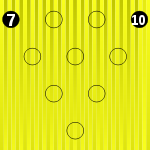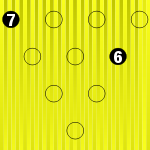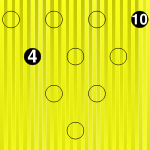.gif)
Split (ten pin bowling)
Encyclopedia
A split is a situation in ten pin bowling in which the first ball
of a frame knocks down the headpin (i.e., the "number 1" pin
) but leaves standing two or more non-adjacent groups of one or more pins. Scoring a spare in this situation is often referred to as a "killer shot".
 The most infamous of splits is the 7–10 split, often called "goal posts" or "bedposts", where the bowler is left with the leftmost and the rightmost pin in the back row (the number 7 and number 10) to knock down with a single ball to achieve a spare
The most infamous of splits is the 7–10 split, often called "goal posts" or "bedposts", where the bowler is left with the leftmost and the rightmost pin in the back row (the number 7 and number 10) to knock down with a single ball to achieve a spare
.
There are two ways to convert this split. The first is to strike either pin and have it bounce out of the pit area and strike the remaining pin. This not only requires substantial ball speed but the pin must be struck in the right spot. Additionally, a pin flying out from the pit is a fairly rare occurrence. The second method is to strike either pin on the inside with enough velocity to bounce it off the side wall (kickback plate) and rebound onto and across the deck into the other pin. Sliding the pin directly will not work since the ball will fall off the lane before it gets far enough aside the 7 or 10 pin to slide it directly across. Despite this fact, many television shows and movies over the years have depicted the 7–10 split being converted by directly sliding one pin into another. In each case, the "conversion" was rigged by either moving the sliding pin over on a deck without pin spots (giving the ball extra room to slide the pin sideways and making it look like the pin was spotted correctly) or by having some help (human or mechanical) from the pit to "slide" the pin over. Barring such "Hollywood magic" in real life, a freak bounce out of the pit or a side wall rebound are the only realistic ways to convert a 7–10 split.

 It is possible to hit the pin on the back row (the 7 or the 10) by hitting the pin in the third row (the 6 or the 4) at a very fine angle.
It is possible to hit the pin on the back row (the 7 or the 10) by hitting the pin in the third row (the 6 or the 4) at a very fine angle.
This is similar to the 7–10, as they are both splits with pins on the back row of the deck. It is also just about as difficult to convert. However, it is possible to slide the 9 or 8-pin into the 7 or 10 pin, but there is only a 0.05 inch (1 mm) margin of error.
(5–7) or Woolworth or Dime Store (5–10)
Similar to a 6–7 split, but since the pins are closer, the 5 pin does not need to be hit at such a fine angle to hit the 7 pin. Another rare method is to deflect an extremely light ball (under 10 lb) between the two pins.
Sour Apple or Lily (5–7–10)
Similar to above, one must use a light ball (under 10 lb) to deflect the 5 pin into either the 7 or 10 pin and deflect your ball off the 5 pin into the other back pin. It is also possible to slide the 5 pin into either the 7 or 10 pin, and with luck, either the 5 or 7 (or 10, depending on which side the bowler chooses to go) pin will slide or roll into the other pin. It is among the most difficult splits to covert.
The 5–7–10 is considered the most embarrassing split of all, because not only is it almost impossible to make, it is left by throwing a "flat ball", that is, a shot with no revolutions or action on it.
3–7 split
Similar to a 5–7 split, but since the 3 is one row further from the 7 than the 5, you must hit the right side of the 3 pin at only a slight angle.
Baby split (2–7)
This is the easiest split to convert since you have two options. You can slide the 2 pin into the 7 pin. The other option is to deflect the ball between the two pins. This can be achieved with a ball of any weight since the pins are close enough together.
Cocked Hat (2–7–10 or 3–7–10)
This split is basically the Baby Split with another pin. The player ignores the pin most "distant" from the other and plays the Baby Split. With luck, the pin should be able to slide to get the other pin.
The Big Four (4–6–7–10)
The "Big Four" split consists of the two pins on either side of the pin deck. It is similar to the 4–7–10 and the 6–7–10, as a common attempt to make the split will consist of sliding the 4 or 6 pin into the remaining two pins on the other side (the ball will take out either the 7 or 10 pin). As with virtually all splits, it is possible to make by bouncing a pin out of the pit.
Side-by-Side splits (2–3; 4–5; 5–6; 7–8; 8–9; 9–10)
Similar to baby splits because of their close distance from one another, the side-by-side split is almost always made by fitting the ball in between the two pins left standing. A much rarer conversion of the split involves sliding one pin into the other. A similar split (4–5–7 or 5–6–10) should be made the same way. Also called "Fit splits."
The Washout
Although not a split, as the headpin (or No.1 pin) is still standing, washouts involve a setup of pins which are spaced out; the setup must include the head pin (the 1 pin). Common examples of the washout include the 1–2–4–10, 1–2–8–10, 1–3–6–7, and the 1–2–10. Washouts are easier than most splits, because the head pin is much more in front of the pin deck and therefore gives the bowler more room for error. The type of washout one leaves largely depends on if the bowler is left-handed or right-handed. For example, a left-handed bowler would leave washouts such as the 1–3–6–7 and 1–3–7–9, while a right-handed bowler would leave washouts such as the 1–2–4–10 and the 1–2–8–10.
The Greek Church (4–6–7–8–10 or 4–6–7–9–10)
This split is similar to the Big Four, except there is another pin included (either the 8 or 9 pin). This split is slightly easier to convert than the Big Four, because sliding the 6-pin over (for right-handers) will sometimes cause the 6-pin to ricochet off the 9-pin and set a crash course for the 4 and 7 pins.
The Big Five (3–4–6–7–10 or 2–4–6–7–10)
This split is most easily converted by sliding either the 2-pin (for left-handers) or the 3 pin (for right-handers) into the two pins on the other side of the pin deck. The ball should take out either the 6–10 (for right-handers) or the 4–7 (for left-handers).
The Big Six (2–4–6–7–8–10 or 3–4–6–7–9–10) a.k.a. Greek Cathedral a.k.a Four Through the Middle
This split is similar to the Big Five, but is made slightly harder because there is another pin in the back row, creating a split with two pins on one side and four pins on the other. The split should be made with a drastic curve on the back end of the lane, so that the ball can convert the four pins and have the frontmost pin take the two remaining pins out.
4-7-10 and 6-7-10 Splits
These splits are similar to the 7-10 split, but are easier to pick up because of the extra pin. Always aim the to side with the two pins to ensure a possibility of a pick-up.
", coming from the fact that in American football
, you must kick the ball between two huge metal poles to get a field goal.
Recorded 4–6–7–10 split conversions
Bowling ball
A bowling ball is a spherical ball made from plastic, reactive resin, urethane or a combination of these materials which is used in the sport of bowling. Ten-pin bowling balls generally have a set of three holes drilled in them, one each for the ring and middle finger, and one for the thumb;...
of a frame knocks down the headpin (i.e., the "number 1" pin
Bowling pin
Bowling pins are the target of the bowling ball in various bowling games including tenpins, five-pins, duckpins, and candlepins. In the US, pin specifications for standard tenpins are set by the United States Bowling Congress. Pins are 4.75 inches wide at their widest point and tall...
) but leaves standing two or more non-adjacent groups of one or more pins. Scoring a spare in this situation is often referred to as a "killer shot".
7–10 split

Spare (bowling)
A spare is a term used in bowling to indicate that all of the pins have been knocked down after the second ball of a frame. The symbol for a spare is a slash mark ....
.
There are two ways to convert this split. The first is to strike either pin and have it bounce out of the pit area and strike the remaining pin. This not only requires substantial ball speed but the pin must be struck in the right spot. Additionally, a pin flying out from the pit is a fairly rare occurrence. The second method is to strike either pin on the inside with enough velocity to bounce it off the side wall (kickback plate) and rebound onto and across the deck into the other pin. Sliding the pin directly will not work since the ball will fall off the lane before it gets far enough aside the 7 or 10 pin to slide it directly across. Despite this fact, many television shows and movies over the years have depicted the 7–10 split being converted by directly sliding one pin into another. In each case, the "conversion" was rigged by either moving the sliding pin over on a deck without pin spots (giving the ball extra room to slide the pin sideways and making it look like the pin was spotted correctly) or by having some help (human or mechanical) from the pit to "slide" the pin over. Barring such "Hollywood magic" in real life, a freak bounce out of the pit or a side wall rebound are the only realistic ways to convert a 7–10 split.
6–7 and 4–10 splits


Other common splits
Cincinnati (7–9 or 8–10)This is similar to the 7–10, as they are both splits with pins on the back row of the deck. It is also just about as difficult to convert. However, it is possible to slide the 9 or 8-pin into the 7 or 10 pin, but there is only a 0.05 inch (1 mm) margin of error.
(5–7) or Woolworth or Dime Store (5–10)
Similar to a 6–7 split, but since the pins are closer, the 5 pin does not need to be hit at such a fine angle to hit the 7 pin. Another rare method is to deflect an extremely light ball (under 10 lb) between the two pins.
Sour Apple or Lily (5–7–10)
Similar to above, one must use a light ball (under 10 lb) to deflect the 5 pin into either the 7 or 10 pin and deflect your ball off the 5 pin into the other back pin. It is also possible to slide the 5 pin into either the 7 or 10 pin, and with luck, either the 5 or 7 (or 10, depending on which side the bowler chooses to go) pin will slide or roll into the other pin. It is among the most difficult splits to covert.
The 5–7–10 is considered the most embarrassing split of all, because not only is it almost impossible to make, it is left by throwing a "flat ball", that is, a shot with no revolutions or action on it.
3–7 split
Similar to a 5–7 split, but since the 3 is one row further from the 7 than the 5, you must hit the right side of the 3 pin at only a slight angle.
Baby split (2–7)
This is the easiest split to convert since you have two options. You can slide the 2 pin into the 7 pin. The other option is to deflect the ball between the two pins. This can be achieved with a ball of any weight since the pins are close enough together.
Cocked Hat (2–7–10 or 3–7–10)
This split is basically the Baby Split with another pin. The player ignores the pin most "distant" from the other and plays the Baby Split. With luck, the pin should be able to slide to get the other pin.
The Big Four (4–6–7–10)
The "Big Four" split consists of the two pins on either side of the pin deck. It is similar to the 4–7–10 and the 6–7–10, as a common attempt to make the split will consist of sliding the 4 or 6 pin into the remaining two pins on the other side (the ball will take out either the 7 or 10 pin). As with virtually all splits, it is possible to make by bouncing a pin out of the pit.
Side-by-Side splits (2–3; 4–5; 5–6; 7–8; 8–9; 9–10)
Similar to baby splits because of their close distance from one another, the side-by-side split is almost always made by fitting the ball in between the two pins left standing. A much rarer conversion of the split involves sliding one pin into the other. A similar split (4–5–7 or 5–6–10) should be made the same way. Also called "Fit splits."
The Washout
Although not a split, as the headpin (or No.1 pin) is still standing, washouts involve a setup of pins which are spaced out; the setup must include the head pin (the 1 pin). Common examples of the washout include the 1–2–4–10, 1–2–8–10, 1–3–6–7, and the 1–2–10. Washouts are easier than most splits, because the head pin is much more in front of the pin deck and therefore gives the bowler more room for error. The type of washout one leaves largely depends on if the bowler is left-handed or right-handed. For example, a left-handed bowler would leave washouts such as the 1–3–6–7 and 1–3–7–9, while a right-handed bowler would leave washouts such as the 1–2–4–10 and the 1–2–8–10.
The Greek Church (4–6–7–8–10 or 4–6–7–9–10)
This split is similar to the Big Four, except there is another pin included (either the 8 or 9 pin). This split is slightly easier to convert than the Big Four, because sliding the 6-pin over (for right-handers) will sometimes cause the 6-pin to ricochet off the 9-pin and set a crash course for the 4 and 7 pins.
The Big Five (3–4–6–7–10 or 2–4–6–7–10)
This split is most easily converted by sliding either the 2-pin (for left-handers) or the 3 pin (for right-handers) into the two pins on the other side of the pin deck. The ball should take out either the 6–10 (for right-handers) or the 4–7 (for left-handers).
The Big Six (2–4–6–7–8–10 or 3–4–6–7–9–10) a.k.a. Greek Cathedral a.k.a Four Through the Middle
This split is similar to the Big Five, but is made slightly harder because there is another pin in the back row, creating a split with two pins on one side and four pins on the other. The split should be made with a drastic curve on the back end of the lane, so that the ball can convert the four pins and have the frontmost pin take the two remaining pins out.
4-7-10 and 6-7-10 Splits
These splits are similar to the 7-10 split, but are easier to pick up because of the extra pin. Always aim the to side with the two pins to ensure a possibility of a pick-up.
Equivalent splits
Since the pins are set up as an equilateral triangle, identically spaced splits can occur on different parts of the lane. Converting them would be done in the same manner.- 7–9 = 8–10, 4–6
- 5–7 = 2–6, 3–4, 4–9, 5–10, 6–8
- 3–7 = 2–10
- 3–10 = 2–7, 2–9, 3–8, 1–4, 1–-6 (technically the last two are not splits)
- 2–3 = 4–5, 5–6, 7–8, 8–9, 9–10 (known as "Fit Splits")
"Field goals"
In popular culture today, many people will call a ball rolled through the middle of a split a "field goalField goal (football)
A field goal in American football and Canadian football is a goal that may be scored during general play . Field goals may be scored by a placekick or the now practically extinct drop kick.The drop kick fell out of favor in 1934 when the shape of the ball was changed...
", coming from the fact that in American football
American football
American football is a sport played between two teams of eleven with the objective of scoring points by advancing the ball into the opposing team's end zone. Known in the United States simply as football, it may also be referred to informally as gridiron football. The ball can be advanced by...
, you must kick the ball between two huge metal poles to get a field goal.
External links
Recorded 7–10 split conversions in televised bowling eventsRecorded 4–6–7–10 split conversions

